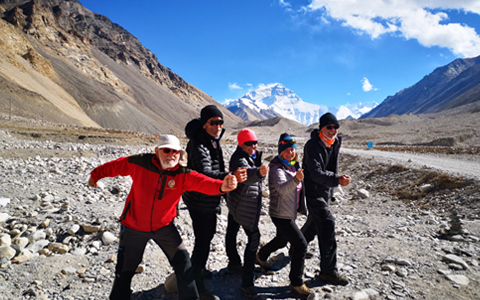Lhasa is a must-visit destination on any Tibet tour. Even if you don't plan to go elsewhere, Lhasa offers plenty of attractions and activities to occupy you for weeks. To make the most of your Lhasa visit, don’t miss these 10 essential tips from our local guide.
1. When Arriving in Lhasa either by Flight or Train, Walk Slowly
Most tourists visiting Lhasa (3650 meters) come from lower-altitude areas where oxygen is abundant. Once you go over 2500 meters above sea level, the quantity of oxygen in the air declines. So you may suffer from altitude sickness in Lhasa, and have common symptoms like headache and fatigue.
It is recommended to take it slow after you arrive in Lhasa, whether by flight or train. Avoid any exertion during the first days of your stay. Walk slowly, drink plenty of water, and rest as much as possible, so you can adjust to the altitude better and more quickly.
Our four-day Lhasa tour allows ample time for attitude adaption upon arrival.
2. Avoid Taking a Shower During Your First Two Days in Lhasa
It is not recommended to take a shower in the first two days of your stay in Lhasa. This can make you more likely to catch a cold, as Tibet has low temperatures. Colds are hard to cure in Tibet and can even lead to severe lung disease.
Also, taking a shower on a high-altitude plateau can make altitude sickness worse. Overheated water will accelerate blood circulation and increase oxygen consumption. You may also overexert yourself during a bath.
However, you can wash your hair to stay refreshed and clean, which is much safer. It is convenient to wash your hair, as hotels in Lhasa provide 24-hour hot water supplies. Hair dryers are also available for you to dry your hair quickly.
 Avoid taking a shower during your first two days in Lhasa
Avoid taking a shower during your first two days in Lhasa3. Stay at a Hotel in Lhasa Close to Potala Palace and Barkhor Street
When choosing your accommodation in Lhasa, it is recommended to stay near iconic landmarks such as the Potala Palace and Barkhor Street, both located in the city center.
In this way, you can reduce travel time and have a better experience. For example, some hotels allow you to see the Potala Palace from your room window. Or you can easily walk to the Barkhor Street when you stay nearby.
It is also more convenient for dining and shopping when staying in these downtown areas. You can better immerse yourself in the cultural atmosphere of Lhasa and have a more enjoyable travel experience.
 You can choose to stay in a hotel with Potala Palace view.
You can choose to stay in a hotel with Potala Palace view.4. Protect Yourself from the Sunburn, Even on Cloudy Days in Lhasa
Lhasa city has abundant sunlight all year round, and thus is called “the City of Sunshine”. Although it may not seem so at high elevations, sunlight can cause sunburns with ease. Since the atmosphere is thinner than at lower altitudes, you are more susceptible to sunburns due to higher exposure.
For prevention, bring high-quality sunscreen, even on cloudy days, and apply it regularly on exposed parts of the body, such as the face and hands. Also, wear a hat with a wide brim and long-sleeved shirts, and have sunglasses at hand.
If you get sunburns accompanied with fever, dehydration, and nausea among other symptoms, contact your tour guide and seek medical assistance immediately.
 The sunshine in Lhasa is strong even in winter.
The sunshine in Lhasa is strong even in winter.Join our Lhasa small group tour to visit essence of Lhasa city
5. Ensure You Book Tickets for Potala Palace and Jokhang Temple in Advance
The famous Potala Palace and revered Jokhang Temple are two of the most popular attractions in Lhasa, attracting crowds of tourists throughout the year. It is best to book tickets for these landmarks in advance, to avoid any delay of your schedule.
The Potala Palace does not sell the same-day tickets. The booking system typically opens for ticket sales ten days or one week in advance. And it is not recommended to cancel your tickets multiple times after booking, as this may result in being placed on a backlist for tourists.
Also, tickets for Jokhang Temple can only be booked one day in advance. As the holiest place of worship in the Tibetan Plateau, it not only attracts tourists but also numerous pilgrims. Be sure to plan your schedule carefully to make the most of your visit.
Luckily, we will help to book tickets for these attractions if you join our Lhasa tours. This way, you can enjoy a hassle-free experience.
 We will secure your tickets to famous landmarks like Potala Palace.
We will secure your tickets to famous landmarks like Potala Palace.6. Ensure to Enjoy a Cup of Sweet Tea with Locals at a Tibetan Teahouse
If you want to experience and learn about local Tibetan daily life, the best way is to visit a Tibetan teahouse. Lhasa has many big and small teahouses, where locals always gather to chat and relax.
At the teahouse, you can enjoy a cup of Tibetan sweet tea, which is often more popular than the traditional Tibetan butter tea among tourists. You can also eat some local Tibetan food, such as Tibetan noodles and Momos (Tibetan dumplings). It is a unique experience you should not miss when visiting Lhasa.
 It's a unique experience to enjoy Tibetan sweet tea in local teahouse.
It's a unique experience to enjoy Tibetan sweet tea in local teahouse.7. Independent Travel in Lhasa Isn't Allowed After the Tour, but...
All international tourists are required to join a tour to visit Tibet. During your stay in Lhasa, you will be accompanied by a local tour guide every day. This also means you cannot travel independently after your guided tour.
But you can stroll around near your hotel, to grab a bite to eat or do some shopping. If you wish to visit a place farther from your hotel, you can contact your tour guide to accompany you. Your guide can help lead the way and ensure a smooth experience.
Our Lhasa small group tour offers quality service including thoughtful local guide.
8. Nowadays, Lhasa Can Experience Traffic During Peak Hours
Contrary to what many people might suppose, Lhasa is a busy city to some degree nowadays. With a growing population, traffic jam can occur during peak hours.
So it is best to plan your activities early and reserve enough time for transportation. Especially, if you go to the airport, which is 55 km away from downtown, you’d better avoid the peak hours or leave well in advance.
Also, some streets like those around Jokhang Temple may be under traffic control from time to time. This means you may need to walk a long distance before or after a car ride. Be sure to check the real-time traffic info before your departure.
 We provide Lhasa Gongga Airport pick up service.
We provide Lhasa Gongga Airport pick up service.9. If Budget Allows, Consider an Extra 20-40USD for an Oxygen-Supplied Hotel in Lhasa
No matter your physical fitness, you may experience altitude sickness during your stay in Lhasa. To make yourself more comfortable and recover as quickly as possible, it is recommended to choose an oxygen-supplied hotel for overnight stays, if your budget allows.
Usually you only need to pay an additional 20 to 40 USD per night, but the oxygen supply in the hotel can help you breathe easier and sleep better. This can make a big difference, ensuring you feel more energetic for sightseeing during the daytime.
 You can consider staying in a hotel with oxygen supply in Lhasa.
You can consider staying in a hotel with oxygen supply in Lhasa.10. Lhasa: A Destination Worth Visiting Once, Twice, and All Year Round
Lhasa is a year-round destination and presents different charms in every season. From the vibrant festivities of summer to the tranquil atmosphere of winter, you can always enjoy a unique wonderful experience in Lhasa throughout the year.
Only one visit to Lhasa is simply not enough. The city has so much to offer, blending deeply rooted culture with modern development. You can visit the revered Buddhist monasteries, photograph migrating birds, explore night clubs, and even trek in the suburban area, etc.
 Lhasa has much to offer including mysterious Buddhist monasteries.
Lhasa has much to offer including mysterious Buddhist monasteries.We Are Based in Lhasa and Always Ready to Show You the Authentic Lhasa Experience
As the leading local Tibet tour operator, we are based in Lhasa and have years of experience. We offer a wide selection of well-designed Lhasa tours, and are dedicated to providing you with an authentic experience of this incredible city.
From helping to obtain your Tibet Travel Permit to arranging suitable accommodation, knowledgeable local Tibetan guides, and seamless railway or airport transfer, we take care of every detail. Join us to enjoy a truly smooth and enjoyable Lhasa journey.
Join our Lhasa tour to have an authentic travel experience
Conclusion
Lhasa is usually the starting point for a Tibet tour, and a charming place you can explore time and time again. By following these local tips, you will enjoy a more comfortable and worry-free journey in this holy city. If you have more questions, feel free to contact us! We are here to help you create a truly memorable journey of a lifetime!


























 Avoid taking a shower during your first two days in Lhasa
Avoid taking a shower during your first two days in Lhasa You can choose to stay in a hotel with Potala Palace view.
You can choose to stay in a hotel with Potala Palace view. The sunshine in Lhasa is strong even in winter.
The sunshine in Lhasa is strong even in winter. We will secure your tickets to famous landmarks like Potala Palace.
We will secure your tickets to famous landmarks like Potala Palace. It's a unique experience to enjoy Tibetan sweet tea in local teahouse.
It's a unique experience to enjoy Tibetan sweet tea in local teahouse. We provide Lhasa Gongga Airport pick up service.
We provide Lhasa Gongga Airport pick up service. You can consider staying in a hotel with oxygen supply in Lhasa.
You can consider staying in a hotel with oxygen supply in Lhasa. Lhasa has much to offer including mysterious Buddhist monasteries.
Lhasa has much to offer including mysterious Buddhist monasteries.










Ask a Quick Question